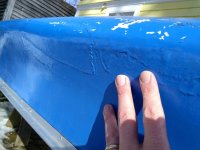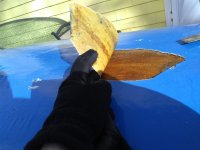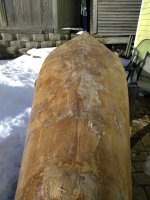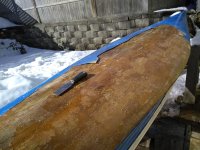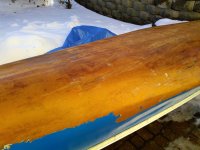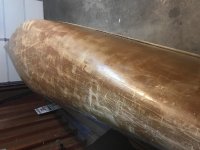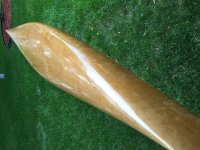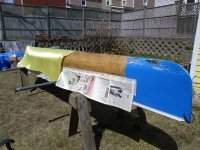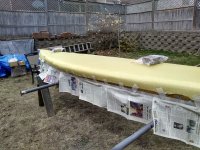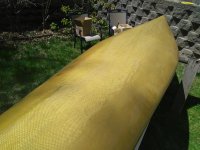I've been vicariously enjoying the builds that Jim Dodd and Deerfly have been doing, and with nice weather today, I decided to start on a restoration project that's been on my list for a long time.
I have this old 1984 Wenonah C1W in kevlar ultralight. It's a beater boat with a lot of battle scars. At some point a previous owner decided to put a "new bottom" on the boat in the form of three big pieces of cloth, each about 5 feet long. I'm not sure what the material was, maybe 6oz e-glass, something from the auto parts store, potatoe sacks, who knows. Anyway these big patches had started to delaminate badly, coming off in chunks and allowing water between them and the original hull. This is my go-to solo boat these days, so I figured I'd bite the bullet and do an overhaul.


The only tools I used in tearing off the crap were a putty knife and a paint scraper. Mostly I just used my gloved hands. The fabric had deteriorated badly (UV?), and it tore as easily as duct tape.
I'm happy with what I found under the lizard skin. Sometimes the demo is the scariest part of the project, since that's usually when you find out things are worse than you thought. My biggest worry was that only half the crap would come off, so I'd be stuck working around the stubborn pieces, but that turned out not to be an issue. The newly exposed hull is in better shape than I expected. I still have a lot of sanding and scraping work to do before it's ready for its new underbelly, but there's nothing fundamentally wrong.
I collected all the debris in a trash bag and weighed it: 5.5 lbs. Depending on what I add, this boat may lose a couple pounds on net. It was in the neighborhood of 41# when I started.
I haven't decided what fabric(s) I'm going to use. I might just add one layer of 6oz s-glass and call it good, or I might do a layer of kevlar by itself, or a layer of kevlar followed by glass. Suggestions appreciated! The way Wenonah lays up these boats, with a diamond shaped foam core in the football area and not much outside it, they're very vulnerable to rock strikes just above the waterline. I wouldn't mind adding some toughness. It's too cold for epoxy work now, so I have some time to think about it.
I have this old 1984 Wenonah C1W in kevlar ultralight. It's a beater boat with a lot of battle scars. At some point a previous owner decided to put a "new bottom" on the boat in the form of three big pieces of cloth, each about 5 feet long. I'm not sure what the material was, maybe 6oz e-glass, something from the auto parts store, potatoe sacks, who knows. Anyway these big patches had started to delaminate badly, coming off in chunks and allowing water between them and the original hull. This is my go-to solo boat these days, so I figured I'd bite the bullet and do an overhaul.
The only tools I used in tearing off the crap were a putty knife and a paint scraper. Mostly I just used my gloved hands. The fabric had deteriorated badly (UV?), and it tore as easily as duct tape.
I'm happy with what I found under the lizard skin. Sometimes the demo is the scariest part of the project, since that's usually when you find out things are worse than you thought. My biggest worry was that only half the crap would come off, so I'd be stuck working around the stubborn pieces, but that turned out not to be an issue. The newly exposed hull is in better shape than I expected. I still have a lot of sanding and scraping work to do before it's ready for its new underbelly, but there's nothing fundamentally wrong.
I collected all the debris in a trash bag and weighed it: 5.5 lbs. Depending on what I add, this boat may lose a couple pounds on net. It was in the neighborhood of 41# when I started.
I haven't decided what fabric(s) I'm going to use. I might just add one layer of 6oz s-glass and call it good, or I might do a layer of kevlar by itself, or a layer of kevlar followed by glass. Suggestions appreciated! The way Wenonah lays up these boats, with a diamond shaped foam core in the football area and not much outside it, they're very vulnerable to rock strikes just above the waterline. I wouldn't mind adding some toughness. It's too cold for epoxy work now, so I have some time to think about it.

